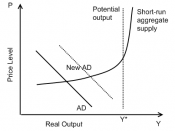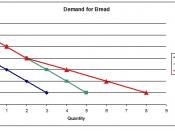Unemployment is a pressing economic problem across countries over different periods of time. Unemployment may be defined as the state in which individuals who are available to work and actively seeking jobs remain unemployed (Mankiw, 2007; Colander, 2004). It has adverse effects not only on individuals but also on the whole economy (Dornbusch et al, 2004). Hence, it is crucial that nations concentrate on unemployment issue and deal with it appropriately. Although some unemployment is inevitable, policies like monetary and fiscal policies are accessible ways to mitigate the severe consequences of unemployment. This essay will outline three types of unemployment and explain the possible demand side and supply side policies associated with evaluations.
Generally, economists divide unemployment into three categories: frictional unemployment, structural unemployment and cyclical unemployment. Firstly, frictional unemployment is unemployment due to qualified individuals' transitions between jobs (Mankiw, 2007; Arnold, 2004). It is inevitable even when the economy is operating at full because labor demand changes incessantly, inducing people to move between jobs (Mankiw, 2007; Colander, 2004).
However, the fact is that people have different abilities and preferences, while skill requirements of jobs differ, and information about jobs spreads always slowly as well (Mankiw, 2007; Dornbusch et al, 2004; Institute for Fiscal Studies Virtual Economy, nd). Hence, frictional unemployment arises because it is time-consuming for workers to find an appropriate new jobs and matching workers with jobs is not instantaneous (Mankiw, 2007; Arnold, 2004). Secondly, structural unemployment is unemployment arises because inadequate supply of jobs in some labor markets cannot meet the demand for jobs owing to economic restructure (Mankiw, 2007; Colander, 2004). Economy develops with structural changes, thus, creating demand for one kind of labor and eliminate another kind of job opportunities (Mankiw, 2007; Samuelson and Nordhaus, 2002; Arnold, 2004). Therefore, employees who have no transferable skills...


